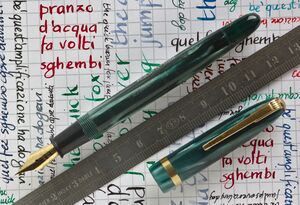Differenze tra le versioni di "Astura/en"
(Creata pagina con "The production under this brand saw an huge variety of different models made with the most different filling systems and the most varied forms, in a sort of trial both technic...") |
(Creata pagina con "The production is dated to be in the period from the 30s to mid 50s. Although clearly low-end pens, there are particularly interesting models like the versions with a special...") |
||
| Riga 6: | Riga 6: | ||
The production under this brand saw an huge variety of different models made with the most different filling systems and the most varied forms, in a sort of trial both technical and stylistic. There is no known start date for its use, but the trademark was registered by [[SAFIS]] in [[1936]] ({{Marchio|54056}}) which in the absence of more precise indications we will also assume to be the year of the production beginning. | The production under this brand saw an huge variety of different models made with the most different filling systems and the most varied forms, in a sort of trial both technical and stylistic. There is no known start date for its use, but the trademark was registered by [[SAFIS]] in [[1936]] ({{Marchio|54056}}) which in the absence of more precise indications we will also assume to be the year of the production beginning. | ||
| − | + | The production is dated to be in the period from the 30s to mid 50s. Although clearly low-end pens, there are particularly interesting models like the versions with a special vacuum filling system, made of transparent celluloid. | |
La produzione a marchio ''Astura'' degli anni '30 e '40 è estremamente variegata, con una produzione orientata alle penne economiche ad ampia distribuzione, realizzate in numerosissime varianti di finiture, forme e colori. Negli anni '50 con la crisi causata dall'avvento delle penne a sfera usa e getta vennero prodotti modelli sempre più economici e di bassa qualità. | La produzione a marchio ''Astura'' degli anni '30 e '40 è estremamente variegata, con una produzione orientata alle penne economiche ad ampia distribuzione, realizzate in numerosissime varianti di finiture, forme e colori. Negli anni '50 con la crisi causata dall'avvento delle penne a sfera usa e getta vennero prodotti modelli sempre più economici e di bassa qualità. | ||
Versione delle 00:48, 31 gen 2022
| Astura |
|---|
| Brand pages |
| Brand advertising |
| Brand photos |
The "Astura" brand was probably born, alongside the brand Radius, with the restructuring and change of name of The King that gives life to SAFIS, and it was dedicated for the production into the economic range.
The production under this brand saw an huge variety of different models made with the most different filling systems and the most varied forms, in a sort of trial both technical and stylistic. There is no known start date for its use, but the trademark was registered by SAFIS in 1936 (Reg. Gen. N. 54056) which in the absence of more precise indications we will also assume to be the year of the production beginning.
The production is dated to be in the period from the 30s to mid 50s. Although clearly low-end pens, there are particularly interesting models like the versions with a special vacuum filling system, made of transparent celluloid.
La produzione a marchio Astura degli anni '30 e '40 è estremamente variegata, con una produzione orientata alle penne economiche ad ampia distribuzione, realizzate in numerosissime varianti di finiture, forme e colori. Negli anni '50 con la crisi causata dall'avvento delle penne a sfera usa e getta vennero prodotti modelli sempre più economici e di bassa qualità.
La produzione Astura pare essere terminata nella seconda metà degli anni '50, cosa avvenuta anche per la Radius, a causa della probabile cessazione delle attività della casa madre SAFIS, probabilmente messa fuori mercato dal successo delle penne a sfera. Non ci sono però documenti attendibili o indicazioni precise riguardo la cessazione delle attività.
